Cheap Hedonism
Solo exhibition, Cheap Hedonism, Dittrich & Schlechtriem, Berlin, Germany, 2023
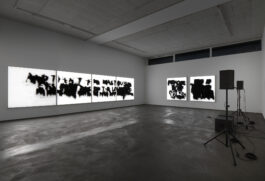
IF THIS IS YOU WHO AM I, installation view, Cheap Hedonism, Dittrich & Schlechtriem, Berlin, Germany, 2023
Cheap Hedonism includes an immersive light and sound installation in collaboration with Yasmina Dexter and Elias Asisi in the main subterranean gallery space, and is accompanied by a series of text paintings and works on paper.
Visitors arriving at the gallery are welcomed by a large-format painting; letters on a luminous red ground spell the exhibition’s title: Cheap Hedonism. The sounds of a twenty-minute multimedia installation can be heard from downstairs and guide the visitors toward the gallery’s underground exhibition space. In the anteroom leading to the main gallery, papers reminiscent of square notepads, mounted under acrylic glass covers, reveal intimate notes, phrases, and poetic fragments in Richthofen’s hand. Confronted with the artist’s unfiltered thoughts, the visitors are invited to delve into a reflection on their own feelings and thoughts.
The exhibition’s centerpiece is set up in the main gallery. The installation titled If This Is You Who Am I consists of seven lightboxes spray-painted with acrylic paint that pulse in the rhythm of a two-channel sound file by Yasmina Dexter. Richthofen recorded the texts reproduced on the light boxes; Dexter then subjected the recordings to acoustic manipulation. In the course of the piece, the artist’s spoken words eventually become more and more clearly audible.
Life is not bad at all—perhaps even better?—somewhere in the capitalist system’s interstices. In an age of unbridled consumerism, advancing globalization, and constant availability, we need to subject conventional values to ongoing critical scrutiny. Monty Richthofen’s solo show Cheap Hedonism exposes the pitfalls of social life, builds bridges, allows for vulnerabilities. Exuding a sense of ease, it encourages the visitors to linger and immerse themselves in a place where words in their immediacy evoke a poetics of the everyday dreamt up with eyes open or closed. Richthofen dedicates himself to pop-cultural phenomena and life’s profound questions alike, his playful engagement with language undeterred by seemingly unrecognizable paradoxes, sending shafts of bright light down into reality’s putatively dark fractures.
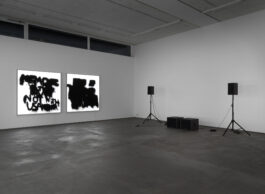
IF THIS IS YOU WHO AM I, installation view, Cheap Hedonism, Dittrich & Schlechtriem, Berlin, Germany, 2023
Blacked Out Again
by Adriano Sack
In philosophical use, hedonism (from the ancient Greek hēdonḗ, ‘pleasure, delight, lust, enjoyment, sensual desire,’ and the suffix –ism) designates a family of theories in which the idea of pleasure plays a central role. Psychological hedonism claims that all our actions aim at heightening pleasure and avoiding pain. Ethical hedonism proposes that considerations of increasing pleasure and decreasing pain determine what we should do or which action is right. Axiological hedonism is the thesis that only pleasure has intrinsic value. Aesthetic hedonism argues that a thing is beautiful exactly when its perception is accompanied by disinterested pleasure. In contrast with these philosophical understandings of the term, hedonism in common parlance often describes an approach to life that is focused solely on momentary sensual pleasures. In that sense, the label hedonism is often used disparagingly, interpreting the phenomenon in question as a symptom of decadence.
Monty Richthofen writes on the subway and at the restaurant, in bed and at the club. But his favorite place to write is a room to himself where he is left to his own devices. He used to write in his notebooks; now he writes on 4-by-4-inch pieces of paper. “A handy format in everyday settings,” the artist says. And one distinguished by the ephemerality he needs: “When I’ve sat down to write and I’ve thrown the third one out, I know that now’s not the time. Then I just call it a day.” Thousands of these papers are scattered around his studio near a lake on the outskirts of Berlin. The nature of the texts isn’t easy to describe. Some read like terse diary entries; others, like aphorisms blending acute insight and obtuseness; yet others, like plotlines for a novella, a short film, a dream in a variety of registers:
“Texas Chainsaw Mascara”
“Sex on E-Scooters”
“My list of dirty hobbies: ”
“Good morning 2 all those you that didn’t sleep yet”
“Mediocre to bad”
“It wasn’t rage” (from the work “Ich bin ein dummer Junge aber dumm bin ich nicht”)
“If I could write …,” Monty Richthofen says, which might (but doesn’t) sound coy given his precise and precious concatenations of words: “I’ve never published a longer cohesive piece of writing. Then again, I often manage to say in two words what I want to say.” Some of his notes are draft tattoos; others he sorts into linear or more complex arrangements that bring out correspondences between them and trace a delicate, fragile, crass narrative of emotional permeability and feathery ambivalence.
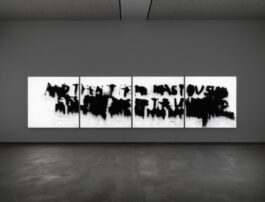
IF THIS IS YOU WHO AM I, installation view, Cheap Hedonism, Dittrich & Schlechtriem, Berlin, Germany, 2023
At first there were these texts, then there was a project that put him on the map. Early on in his time at Central Saint Martins in London, he bought himself a tattoo machine and simply started tattooing. At this point, his work as an artist and the tattoos were strictly separate matters. Until he decided during the work on his thesis piece, which earned him a MullenLowe NOVA People’s Choice Award, that it would all be one: tattoos, writing, graffiti, performance, documentation.
The project was “My Words Your Body” (2017–2019), and it went like this: He met the participants for an extended conversation, then he tattooed a phrase that captured the essence of the encounter and was a good fit. The participants didn’t know what it would be. In the beginning, it was a game for him, an experiment about how far he could go. And in a society in which control over one’s own body and outward appearance is a categorical imperative, this provoked and compliant loss of control was actually a—to use a verboten word— disruptive idea. The artist, who had been a graffiti writer since his teenage years, soon realized that he was not just leaving traces on the skins of others. The process and the interventions were changing him as well. When he describes this practice, he speaks the jargon of a therapist. He mentions a participant who told him about his nine suicide attempts, he talks about responsibility, an exchange of energies, boundaries, trust: “No matter who’s sitting there across from me, I just have to dig deep enough until I can presume to state something about him: Well, this is how I see you.”
“Once I’ve manifested a text in the form of a tattoo, it leaves me,” says Richthofen, who is generally known as Monty. Or Maison, after his nom de plume Maison Hefner (the plume in question being a tattooing needle). Three of his tattoos, though, have not left him to this day:
* “If this is you who am I,” on the back of the head of a woman in Berlin.
* “Home is where the floor is,” after the title of an album by an Australian punk band. “I’d always struggled with the question of what home means. Moved out at 15. Boarding school, host family, my own apartment, several evictions, moving to new cities, romantic dramas. Traveling and restlessness. Home is where I happen to be at the moment. Whenever I want I lie down on the floor and that’s my bed for the night. You just have to be at home in yourself.”
* “I’m not who they promised you I was,” on the chest of a person who’d just transitioned. “This was pretty soon after I got to London. Coming from the extremely masculine graffiti scene, the encounter was a novel experience.” And one that taught him: a body is just an outward form.
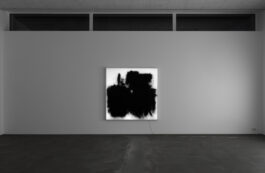
IF THIS IS YOU WHO AM I, installation view, Cheap Hedonism, Dittrich & Schlechtriem, Berlin, Germany, 2023
Both his tattoos and his writings on paper are executed in an awkward hand, with letters crossed out and added, and sometimes veer into illegibility. To heighten the effect, the artist sometimes writes with his left hand. “When it comes to the human body, perfection is a contradiction, because it doesn’t exist. We simply aren’t perfect. Everything that’s asymmetrical looks better. Skin is forever in motion and distorts the letters. The messier and more unreadable and weirder my writing gets, the better it fits on the human body.” The result gives the impression of someone wrestling with language, with words and letters.
Some of them make it onto the big canvas. More specifically, onto a canvas measuring 6.2 by 6.2 feet, which the artist has chosen as a kind of standard format for this exhibition (a scaled-up notepaper, you might say). “Cheap Hedonism,” we read in black letters on a red ground, slightly blurry yet also very assertive. Like a good bouncer, the picture not only points the way to the party, it is also a kind of programmatic opening that sets the mood. What makes the combination of words so brilliant is the complexity that looms beneath its ostensible clarity. Critically trained minds—the only kind of minds, we all know, to walk into a contemporary art gallery—reflexively spot a critique, most likely of the commercialism of the exhibition they have just walked into: the popular trope of inversion in which the artist bites his own hand (gently) and, more importantly, the institution’s.
Minds trained in self-criticism—the only kind of minds, we all know, to walk into a contemporary art gallery—immediately feel caught with their pants down. Aren’t my Prada kicks, my Balenciaga shirt, my outrageously expensive genital piercings exactly what Monty Richthofen subjects to scathing irony with this welcome? Yet that is precisely what “Cheap Hedonism” doesn’t deliver. For the concept is much less well-defined than it seems. What exactly would be its opposite? Expensive hedonism? What would that look like? After all, hedonism, unlike the luxury products that the fashion-tainment complex fires through the social media by the second and hawks in its marketplaces, is not a question of money. You can practice hedonism barefoot and without a valid ticket for your train just as well as (if not better than) at a tasting menu with freshly caught scallops on a black-tea-and-porcini decoction as an extra course. And you suspect that the artist is a man who is adept at both. Although he doesn’t eat fish.
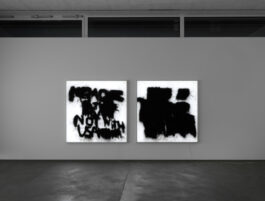
IF THIS IS YOU WHO AM I, installation view, Cheap Hedonism, Dittrich & Schlechtriem, Berlin, Germany, 2023
The same ambivalence made them adopt the name Maison Hefner. When Monty started out as a tattooist, he didn’t have a smartphone. A friend urged him to set up an Instagram account, which now has 110,000 followers—a source of cheap dopamine, today’s heroin, which gets even to a former digital teetotaler like Monty Richthofen. Why the pseudonym Maison Hefner? “I was doing tattoos at my home back then, the name is obviously an allusion to the Playboy Mansion. There was that world-famous iconic mansion, and here I was sitting in my 80-square-foot attic room somewhere in north London—it was the greatest contrast imaginable.”
His exhibition “Cheap Hedonism” culminates in the immersive installation “If This Is You Who Am I,” which consists of large-format lightboxes and a sound collage by the artist Yasmina Dexter. Painting and sound are tied together by a light effects programmed by Elias Asisi. Writing can vaguely be made out on the lightboxes but proves indecipherable because it is contaminated, obscured, and covered up by black paint. The artist’s slowed-down and distorted voice emerges from the soundscape. The longer one spends time in the room, the more clearly one thinks one perceives the illegible texts on the lightboxes, and for a brief and almost entirely elusive instant it feels like one glimpses their meaning. “In painting, I have no use for small formats. I paint with my entire body,” Monty says. The simultaneity of the expansive gesture, whose roots he locates in his graffiti-artist years, and the nebulous effacement and near-disappearance and bubbling-up-again is part of the work’s charm. He redacts his own writing. Which is nonetheless still there. And remains a mystery. “Blacked out again,” as the artist puts it.
The idea of redaction contradicts what many graffiti stand for: the easily legible messages addressed to large numbers of people. The recognition value. The manifestation. The act of marking one’s own existence. The banal and bold claim: “Hey, I was here!”
Humans die, color fades, the tattoos are lasered. Nothing lasts forever. But a start has been made.
The first exhibition that was a formative experience for Adriano Sack was of Andy Warhol’s series “American Myths,” which now looks rather questionable, at the Kestner Gesellschaft in Hannover. He went on to become head of the Style department at WELT AM SONNTAG, a multiple-award-winning writer and newspaper editor, and author of several nonfiction books, including Breites Wissen: Die seltsame Welt der Drogen und ihrer Nutzer (with Ingo Niermann), which has been translated into English as The Curious World of Drugs and Their Friends: A Very Trippy Miscellany, and Gebrauchsanweisung für die USA. He is currently working on his first novel. Sack lives in Berlin and Sicily and to date has no tattoo by Monty Richthofen.
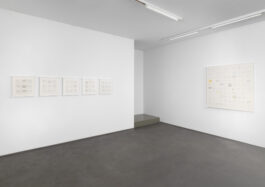
YOUR IDEA OF A SO CALLED LIFE STYLE SUCKS, CHASING SINS, 117 UNREAD MESSAGES, STAY AT HOME, ICH BIN EIN DUMMER JUNG ABER DUMM BIN ICH NICHT, 2022-23, installation view Cheap Hedonism, Dittrich & Schlechtriem, Berlin, Germany, 2023
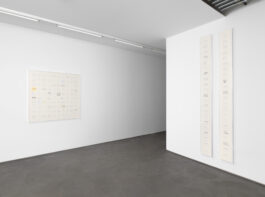
SCROLL 1, SCROLL 2, 2021–23, installation view Cheap Hedonism, Dittrich & Schlechtriem, Berlin, Germany, 2023
Photography by Jens Ziehe
PRESS
Cheap Hedonism
Solo exhibition, Cheap Hedonism, Dittrich & Schlechtriem, Berlin, Germany, 2023

IF THIS IS YOU WHO AM I, installation view, Cheap Hedonism, Dittrich & Schlechtriem, Berlin, Germany, 2023
Cheap Hedonism includes an immersive light and sound installation in collaboration with Yasmina Dexter and Elias Asisi in the main subterranean gallery space, and is accompanied by a series of text paintings and works on paper.
Visitors arriving at the gallery are welcomed by a large-format painting; letters on a luminous red ground spell the exhibition’s title: Cheap Hedonism. The sounds of a twenty-minute multimedia installation can be heard from downstairs and guide the visitors toward the gallery’s underground exhibition space. In the anteroom leading to the main gallery, papers reminiscent of square notepads, mounted under acrylic glass covers, reveal intimate notes, phrases, and poetic fragments in Richthofen’s hand. Confronted with the artist’s unfiltered thoughts, the visitors are invited to delve into a reflection on their own feelings and thoughts.
The exhibition’s centerpiece is set up in the main gallery. The installation titled If This Is You Who Am I consists of seven lightboxes spray-painted with acrylic paint that pulse in the rhythm of a two-channel sound file by Yasmina Dexter. Richthofen recorded the texts reproduced on the light boxes; Dexter then subjected the recordings to acoustic manipulation. In the course of the piece, the artist’s spoken words eventually become more and more clearly audible.
Life is not bad at all—perhaps even better?—somewhere in the capitalist system’s interstices. In an age of unbridled consumerism, advancing globalization, and constant availability, we need to subject conventional values to ongoing critical scrutiny. Monty Richthofen’s solo show Cheap Hedonism exposes the pitfalls of social life, builds bridges, allows for vulnerabilities. Exuding a sense of ease, it encourages the visitors to linger and immerse themselves in a place where words in their immediacy evoke a poetics of the everyday dreamt up with eyes open or closed. Richthofen dedicates himself to pop-cultural phenomena and life’s profound questions alike, his playful engagement with language undeterred by seemingly unrecognizable paradoxes, sending shafts of bright light down into reality’s putatively dark fractures.

IF THIS IS YOU WHO AM I, installation view, Cheap Hedonism, Dittrich & Schlechtriem, Berlin, Germany, 2023
Blacked Out Again
by Adriano Sack
In philosophical use, hedonism (from the ancient Greek hēdonḗ, ‘pleasure, delight, lust, enjoyment, sensual desire,’ and the suffix –ism) designates a family of theories in which the idea of pleasure plays a central role. Psychological hedonism claims that all our actions aim at heightening pleasure and avoiding pain. Ethical hedonism proposes that considerations of increasing pleasure and decreasing pain determine what we should do or which action is right. Axiological hedonism is the thesis that only pleasure has intrinsic value. Aesthetic hedonism argues that a thing is beautiful exactly when its perception is accompanied by disinterested pleasure. In contrast with these philosophical understandings of the term, hedonism in common parlance often describes an approach to life that is focused solely on momentary sensual pleasures. In that sense, the label hedonism is often used disparagingly, interpreting the phenomenon in question as a symptom of decadence.
Monty Richthofen writes on the subway and at the restaurant, in bed and at the club. But his favorite place to write is a room to himself where he is left to his own devices. He used to write in his notebooks; now he writes on 4-by-4-inch pieces of paper. “A handy format in everyday settings,” the artist says. And one distinguished by the ephemerality he needs: “When I’ve sat down to write and I’ve thrown the third one out, I know that now’s not the time. Then I just call it a day.” Thousands of these papers are scattered around his studio near a lake on the outskirts of Berlin. The nature of the texts isn’t easy to describe. Some read like terse diary entries; others, like aphorisms blending acute insight and obtuseness; yet others, like plotlines for a novella, a short film, a dream in a variety of registers:
“Texas Chainsaw Mascara”
“Sex on E-Scooters”
“My list of dirty hobbies: ”
“Good morning 2 all those you that didn’t sleep yet”
“Mediocre to bad”
“It wasn’t rage” (from the work “Ich bin ein dummer Junge aber dumm bin ich nicht”)
“If I could write …,” Monty Richthofen says, which might (but doesn’t) sound coy given his precise and precious concatenations of words: “I’ve never published a longer cohesive piece of writing. Then again, I often manage to say in two words what I want to say.” Some of his notes are draft tattoos; others he sorts into linear or more complex arrangements that bring out correspondences between them and trace a delicate, fragile, crass narrative of emotional permeability and feathery ambivalence.

IF THIS IS YOU WHO AM I, installation view, Cheap Hedonism, Dittrich & Schlechtriem, Berlin, Germany, 2023
At first there were these texts, then there was a project that put him on the map. Early on in his time at Central Saint Martins in London, he bought himself a tattoo machine and simply started tattooing. At this point, his work as an artist and the tattoos were strictly separate matters. Until he decided during the work on his thesis piece, which earned him a MullenLowe NOVA People’s Choice Award, that it would all be one: tattoos, writing, graffiti, performance, documentation.
The project was “My Words Your Body” (2017–2019), and it went like this: He met the participants for an extended conversation, then he tattooed a phrase that captured the essence of the encounter and was a good fit. The participants didn’t know what it would be. In the beginning, it was a game for him, an experiment about how far he could go. And in a society in which control over one’s own body and outward appearance is a categorical imperative, this provoked and compliant loss of control was actually a—to use a verboten word— disruptive idea. The artist, who had been a graffiti writer since his teenage years, soon realized that he was not just leaving traces on the skins of others. The process and the interventions were changing him as well. When he describes this practice, he speaks the jargon of a therapist. He mentions a participant who told him about his nine suicide attempts, he talks about responsibility, an exchange of energies, boundaries, trust: “No matter who’s sitting there across from me, I just have to dig deep enough until I can presume to state something about him: Well, this is how I see you.”
“Once I’ve manifested a text in the form of a tattoo, it leaves me,” says Richthofen, who is generally known as Monty. Or Maison, after his nom de plume Maison Hefner (the plume in question being a tattooing needle). Three of his tattoos, though, have not left him to this day:
* “If this is you who am I,” on the back of the head of a woman in Berlin.
* “Home is where the floor is,” after the title of an album by an Australian punk band. “I’d always struggled with the question of what home means. Moved out at 15. Boarding school, host family, my own apartment, several evictions, moving to new cities, romantic dramas. Traveling and restlessness. Home is where I happen to be at the moment. Whenever I want I lie down on the floor and that’s my bed for the night. You just have to be at home in yourself.”
* “I’m not who they promised you I was,” on the chest of a person who’d just transitioned. “This was pretty soon after I got to London. Coming from the extremely masculine graffiti scene, the encounter was a novel experience.” And one that taught him: a body is just an outward form.

IF THIS IS YOU WHO AM I, installation view, Cheap Hedonism, Dittrich & Schlechtriem, Berlin, Germany, 2023
Both his tattoos and his writings on paper are executed in an awkward hand, with letters crossed out and added, and sometimes veer into illegibility. To heighten the effect, the artist sometimes writes with his left hand. “When it comes to the human body, perfection is a contradiction, because it doesn’t exist. We simply aren’t perfect. Everything that’s asymmetrical looks better. Skin is forever in motion and distorts the letters. The messier and more unreadable and weirder my writing gets, the better it fits on the human body.” The result gives the impression of someone wrestling with language, with words and letters.
Some of them make it onto the big canvas. More specifically, onto a canvas measuring 6.2 by 6.2 feet, which the artist has chosen as a kind of standard format for this exhibition (a scaled-up notepaper, you might say). “Cheap Hedonism,” we read in black letters on a red ground, slightly blurry yet also very assertive. Like a good bouncer, the picture not only points the way to the party, it is also a kind of programmatic opening that sets the mood. What makes the combination of words so brilliant is the complexity that looms beneath its ostensible clarity. Critically trained minds—the only kind of minds, we all know, to walk into a contemporary art gallery—reflexively spot a critique, most likely of the commercialism of the exhibition they have just walked into: the popular trope of inversion in which the artist bites his own hand (gently) and, more importantly, the institution’s.
Minds trained in self-criticism—the only kind of minds, we all know, to walk into a contemporary art gallery—immediately feel caught with their pants down. Aren’t my Prada kicks, my Balenciaga shirt, my outrageously expensive genital piercings exactly what Monty Richthofen subjects to scathing irony with this welcome? Yet that is precisely what “Cheap Hedonism” doesn’t deliver. For the concept is much less well-defined than it seems. What exactly would be its opposite? Expensive hedonism? What would that look like? After all, hedonism, unlike the luxury products that the fashion-tainment complex fires through the social media by the second and hawks in its marketplaces, is not a question of money. You can practice hedonism barefoot and without a valid ticket for your train just as well as (if not better than) at a tasting menu with freshly caught scallops on a black-tea-and-porcini decoction as an extra course. And you suspect that the artist is a man who is adept at both. Although he doesn’t eat fish.

IF THIS IS YOU WHO AM I, installation view, Cheap Hedonism, Dittrich & Schlechtriem, Berlin, Germany, 2023
The same ambivalence made them adopt the name Maison Hefner. When Monty started out as a tattooist, he didn’t have a smartphone. A friend urged him to set up an Instagram account, which now has 110,000 followers—a source of cheap dopamine, today’s heroin, which gets even to a former digital teetotaler like Monty Richthofen. Why the pseudonym Maison Hefner? “I was doing tattoos at my home back then, the name is obviously an allusion to the Playboy Mansion. There was that world-famous iconic mansion, and here I was sitting in my 80-square-foot attic room somewhere in north London—it was the greatest contrast imaginable.”
His exhibition “Cheap Hedonism” culminates in the immersive installation “If This Is You Who Am I,” which consists of large-format lightboxes and a sound collage by the artist Yasmina Dexter. Painting and sound are tied together by a light effects programmed by Elias Asisi. Writing can vaguely be made out on the lightboxes but proves indecipherable because it is contaminated, obscured, and covered up by black paint. The artist’s slowed-down and distorted voice emerges from the soundscape. The longer one spends time in the room, the more clearly one thinks one perceives the illegible texts on the lightboxes, and for a brief and almost entirely elusive instant it feels like one glimpses their meaning. “In painting, I have no use for small formats. I paint with my entire body,” Monty says. The simultaneity of the expansive gesture, whose roots he locates in his graffiti-artist years, and the nebulous effacement and near-disappearance and bubbling-up-again is part of the work’s charm. He redacts his own writing. Which is nonetheless still there. And remains a mystery. “Blacked out again,” as the artist puts it.
The idea of redaction contradicts what many graffiti stand for: the easily legible messages addressed to large numbers of people. The recognition value. The manifestation. The act of marking one’s own existence. The banal and bold claim: “Hey, I was here!”
Humans die, color fades, the tattoos are lasered. Nothing lasts forever. But a start has been made.
The first exhibition that was a formative experience for Adriano Sack was of Andy Warhol’s series “American Myths,” which now looks rather questionable, at the Kestner Gesellschaft in Hannover. He went on to become head of the Style department at WELT AM SONNTAG, a multiple-award-winning writer and newspaper editor, and author of several nonfiction books, including Breites Wissen: Die seltsame Welt der Drogen und ihrer Nutzer (with Ingo Niermann), which has been translated into English as The Curious World of Drugs and Their Friends: A Very Trippy Miscellany, and Gebrauchsanweisung für die USA. He is currently working on his first novel. Sack lives in Berlin and Sicily and to date has no tattoo by Monty Richthofen.

YOUR IDEA OF A SO CALLED LIFE STYLE SUCKS, CHASING SINS, 117 UNREAD MESSAGES, STAY AT HOME, ICH BIN EIN DUMMER JUNG ABER DUMM BIN ICH NICHT, 2022-23, installation view Cheap Hedonism, Dittrich & Schlechtriem, Berlin, Germany, 2023

SCROLL 1, SCROLL 2, 2021–23, installation view Cheap Hedonism, Dittrich & Schlechtriem, Berlin, Germany, 2023
Photography by Jens Ziehe
PRESS
Copyright © 2016–2025 Monty Richthofen. All Rights reserved. Legal. Privacy Policy.
Back to Top
Copyright © 2016–2025 Monty Richthofen. All Rights reserved. Legal. Privacy Policy.